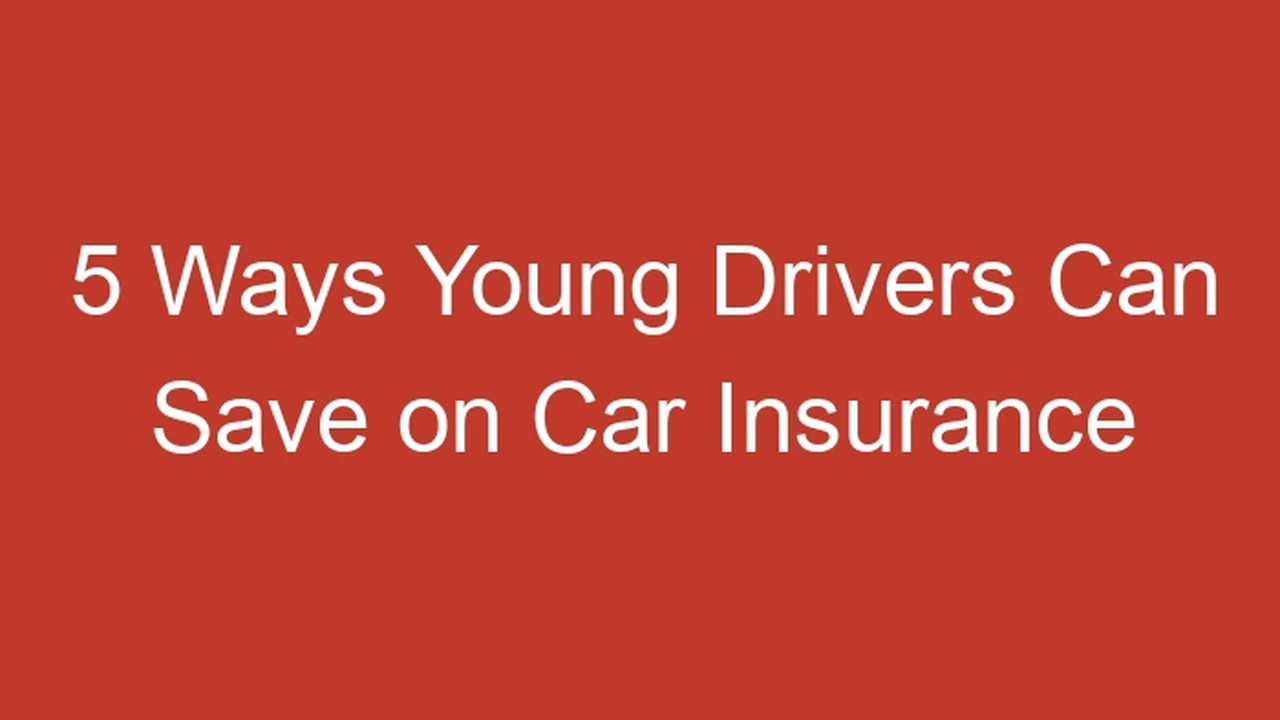Auto Insurance for Young Drivers 4 Key Considerations
Get 4 key considerations for auto insurance for young drivers. Learn how to find affordable rates and essential coverage for new drivers.

Auto Insurance for Young Drivers 4 Key Considerations
Let's face it, getting auto insurance for a young driver can feel like navigating a minefield. The rates often seem astronomical, and the options can be overwhelming. But don't despair! With the right approach and understanding, you can find affordable and essential coverage for the new drivers in your life. This comprehensive guide will walk you through four key considerations, offering practical advice, product recommendations, and comparison insights to help you make the best decisions.
Understanding the High Cost of Auto Insurance for Young Drivers
Why is auto insurance so expensive for young drivers, especially teenagers and those in their early twenties? It boils down to risk. Statistically, young drivers, particularly males, are involved in more accidents than older, more experienced drivers. Their lack of driving experience, combined with a higher propensity for risky behaviors like speeding or distracted driving, translates into a higher likelihood of filing a claim. Insurance companies use these statistics to calculate premiums, and unfortunately, young drivers fall into a high-risk category. This isn't to say all young drivers are reckless, but the data drives the pricing. Factors like age, gender, vehicle type, location, and even academic performance can all play a role in determining their rates.
Key Consideration 1 Choosing the Right Coverage for Young Drivers
When insuring a young driver, it's tempting to opt for the bare minimum to save money. However, this can be a costly mistake in the long run. While liability coverage is legally required in most places, comprehensive and collision coverage are crucial for protecting your investment in the vehicle and covering potential damages. Here's a breakdown of essential coverage types and why they matter for young drivers:
Liability Coverage Protecting Others
This is the foundation of any auto insurance policy. It covers damages and injuries you cause to other people or their property in an accident. For young drivers, who are more prone to accidents, having adequate liability limits is paramount. If they cause a serious accident, and your liability limits are too low, you could be personally responsible for the remaining costs, which can be financially devastating. Many states have minimum liability requirements, but these are often insufficient to cover serious accidents. Consider increasing your liability limits beyond the state minimums, especially with a young driver on the policy.
Collision Coverage Protecting Your Vehicle
Collision coverage pays for damages to your own vehicle resulting from a collision with another car or object, regardless of who is at fault. Given that young drivers are more likely to be involved in accidents, this coverage is highly recommended, especially if the vehicle is new, financed, or simply valuable. Without it, you'd be responsible for all repair or replacement costs out of pocket.
Comprehensive Coverage Protecting Against Non-Collision Events
Comprehensive coverage protects your vehicle from damages not caused by a collision, such as theft, vandalism, fire, natural disasters (hail, floods), or hitting an animal. While young drivers might not be more prone to these specific incidents, the overall risk of vehicle damage is higher when a less experienced driver is behind the wheel. This coverage offers peace of mind against a wide range of unforeseen circumstances.
Uninsured Underinsured Motorist Coverage Protecting Yourself
This coverage is vital, especially in areas with a high number of uninsured drivers. It protects you and your passengers if you're hit by a driver who doesn't have insurance or doesn't have enough insurance to cover your damages and medical bills. Given the potential for serious injuries in accidents involving young drivers, this coverage is a smart investment.
Medical Payments Personal Injury Protection PIP Covering Medical Expenses
Depending on your state, you might have Medical Payments (MedPay) or Personal Injury Protection (PIP). These cover medical expenses for you and your passengers, regardless of who is at fault in an accident. For young drivers, who might be more susceptible to injuries in an accident, having this coverage can help cover immediate medical costs.
Key Consideration 2 Exploring Discounts and Savings for Young Drivers
While young drivers face higher premiums, there are numerous discounts available that can significantly reduce the cost of their auto insurance. Don't leave money on the table! Here are some of the most common and effective discounts to look for:
Good Student Discount Academic Achievement Savings
Many insurance companies offer discounts to students who maintain a certain GPA (typically a 'B' average or higher). This discount recognizes that responsible students are often responsible drivers. Make sure to provide proof of academic achievement to your insurer.
Driver Education Discount Defensive Driving Course Savings
Completing an approved driver education course or a defensive driving course can often qualify young drivers for a discount. These courses teach valuable skills and demonstrate a commitment to safe driving. Check with your insurance provider for approved courses.
Telematics Programs Usage Based Insurance Savings
Telematics programs, also known as usage-based insurance (UBI), involve installing a device in the car or using a smartphone app to monitor driving habits. Safe driving behaviors like avoiding hard braking, rapid acceleration, and late-night driving can lead to significant discounts. This is an excellent option for young drivers who are confident in their safe driving habits. Popular programs include Progressive's Snapshot, State Farm's Drive Safe & Save, and Allstate's Drivewise. These programs typically offer an initial discount for signing up and then adjust premiums based on actual driving data. For example, a young driver consistently demonstrating safe habits could see savings of 10-30% or more.
Multi Car Discount Bundling Policies Savings
If you have multiple vehicles in your household, insuring them all with the same company can often lead to a multi-car discount. This is a common and easy way to save, especially when adding a young driver to an existing family policy.
Bundling Home and Auto Insurance Policy Savings
Similar to multi-car discounts, bundling your auto insurance with other policies like homeowners or renters insurance from the same provider can result in substantial savings. This is a win-win for both the insurer and the policyholder.
Student Away at School Discount College Student Savings
If your young driver attends college more than a certain distance from home and doesn't take their car with them, you might qualify for a student away at school discount. This acknowledges that they're driving less frequently.
Vehicle Safety Features Discount Modern Car Safety Savings
Cars equipped with modern safety features like anti-lock brakes, airbags, electronic stability control, and anti-theft devices can often qualify for discounts. When choosing a vehicle for a young driver, consider models with these features.
Key Consideration 3 Choosing the Right Vehicle for Young Drivers
The type of vehicle a young driver operates has a significant impact on insurance premiums. Certain cars are inherently more expensive to insure due to their safety ratings, repair costs, and theft rates. Here's what to consider:
Safety Ratings Vehicle Crash Test Performance
Vehicles with high safety ratings from organizations like the Insurance Institute for Highway Safety (IIHS) and the National Highway Traffic Safety Administration (NHTSA) are generally cheaper to insure. These cars are designed to protect occupants in a crash, reducing the likelihood of severe injuries and costly claims. Look for vehicles with 'Good' ratings in crash tests and those with advanced safety features.
Repair Costs Vehicle Maintenance Expense
Cars that are expensive to repair will naturally have higher insurance premiums. This includes luxury vehicles, sports cars, and cars with specialized parts. Opting for a more common, reliable, and affordable-to-repair vehicle can lead to significant savings on insurance.
Theft Rates Vehicle Security Risk
Vehicles that are frequently stolen or targeted by thieves will have higher comprehensive coverage premiums. Research the theft rates for specific car models before purchasing. Cars with good anti-theft systems can also qualify for discounts.
Horsepower and Performance Vehicle Engine Power
High-horsepower, high-performance vehicles are often associated with higher speeds and more aggressive driving, leading to increased accident risk. These cars are almost always more expensive to insure for young drivers. A sensible, lower-horsepower vehicle is a much better choice for a new driver.
Recommended Vehicles for Young Drivers Affordable Insurance Options
When considering a car for a young driver, focus on reliability, safety, and affordability. Here are a few examples of car models that often have lower insurance rates for young drivers, along with their typical price ranges (new and used, as of late 2023/early 2024, prices can vary widely based on condition, mileage, and location):
- Honda Civic: A perennial favorite for its reliability, safety, and fuel efficiency. New models typically range from $24,000 - $32,000. Used models (2015-2020) can be found for $12,000 - $20,000. Insurance is generally reasonable due to its widespread availability of parts and good safety ratings.
- Toyota Corolla: Another highly reliable and safe option, similar to the Civic. New models range from $22,000 - $28,000. Used models (2015-2020) are often $11,000 - $18,000. Excellent safety features and low repair costs contribute to lower insurance premiums.
- Subaru Impreza: Known for its standard all-wheel drive and strong safety ratings. New models are typically $23,000 - $29,000. Used models (2015-2020) can be found for $13,000 - $20,000. Its robust safety features often translate to good insurance rates.
- Mazda 3: Offers a good balance of safety, reliability, and a slightly more engaging driving experience. New models range from $24,000 - $35,000. Used models (2015-2020) are often $12,000 - $19,000. Mazda's focus on safety and quality helps keep insurance costs down.
- Hyundai Elantra: A value-packed option with good safety features and a strong warranty. New models are typically $22,000 - $28,000. Used models (2015-2020) can be found for $10,000 - $17,000. Hyundai's improved reliability and safety have made it a more attractive option for insurers.
Comparison of Insurance Costs for Recommended Vehicles: While exact premiums depend on many factors (driver's age, location, driving record, chosen coverage, etc.), generally, the Honda Civic and Toyota Corolla tend to have the lowest insurance costs among these options due to their ubiquity, low repair costs, and excellent safety records. The Subaru Impreza might be slightly higher due to AWD complexity, and the Mazda 3 and Hyundai Elantra fall somewhere in the middle. Always get quotes for specific models before making a purchase decision.
Key Consideration 4 Parental Involvement and Policy Structure for Young Drivers
How you structure the insurance policy and your ongoing involvement can significantly impact both cost and the young driver's development. Here are crucial aspects to consider:
Adding to an Existing Family Policy Cost Savings and Convenience
In almost all cases, it's cheaper to add a young driver to an existing family auto insurance policy rather than having them get their own separate policy. Family policies often come with multi-car discounts, and the risk is spread across multiple drivers, leading to lower overall premiums. This also simplifies management, as all vehicles and drivers are under one umbrella.
Designating the Primary Driver Policy Implications
When adding a young driver, your insurer will ask who the primary driver of each vehicle is. If the young driver is assigned to an older, less expensive car, this can help keep rates down. If they are assigned to a brand-new, high-value vehicle, expect premiums to be significantly higher. Be honest with your insurer about who drives which car most often, as misrepresenting this can lead to claim denials.
Higher Deductibles Balancing Cost and Risk
Consider increasing your deductibles for comprehensive and collision coverage. A higher deductible means you pay more out-of-pocket if you file a claim, but it also lowers your monthly premium. For young drivers, who might have minor fender benders, a higher deductible could be a way to save on premiums, but ensure you have the funds available to cover it if an incident occurs.
Parental Monitoring and Driving Agreements Safe Driving Habits
Beyond insurance, actively monitor your young driver's habits. Consider implementing a driving agreement that outlines rules, consequences, and expectations. Some telematics programs (like those mentioned above) also offer parental monitoring features, allowing you to track their driving behavior and provide feedback. This not only promotes safer driving but can also reinforce the positive behaviors that lead to insurance discounts.
Regular Policy Reviews Annual Check-ups
Don't just set it and forget it. Review your auto insurance policy annually, especially as your young driver gains more experience. Their rates should decrease over time as they age and maintain a clean driving record. Look for new discounts, compare quotes from different providers, and adjust coverage as needed. For example, once a car is older and paid off, you might consider dropping collision or comprehensive coverage if the vehicle's value no longer justifies the premium.
Comparing Insurance Providers for Young Drivers
Not all insurance companies treat young drivers the same. Some are more aggressive with their pricing, while others offer more competitive rates and specialized discounts. It's crucial to shop around and get quotes from multiple providers. Here's a brief comparison of some major players in the US market and what they often offer for young drivers:
- State Farm: Known for its extensive network of local agents and often competitive rates for young drivers, especially with their 'Steer Clear' program (driver education) and 'Drive Safe & Save' telematics program. They also offer good student discounts.
- GEICO: Often provides some of the most competitive rates, particularly for drivers with clean records. They have strong good student and defensive driver discounts. Their online quoting system is very user-friendly.
- Progressive: Famous for its 'Snapshot' telematics program, which can offer significant savings for safe young drivers. They also have a 'Name Your Price' tool that can help you find coverage within your budget.
- Allstate: Offers 'Drivewise' telematics and 'Good Hands Discount' for safe drivers. They also have a 'TeenSafe' program designed specifically for young drivers, which can include coaching and monitoring features.
- Farmers: Provides a 'Youthful Driver Discount' for drivers under 25 who meet certain criteria, including good grades and completion of driver education. They also have a 'Signal' telematics program.
- Nationwide: Offers 'SmartRide' telematics and 'Good Student Discount.' They are known for their strong customer service and a variety of bundling options.
Recommendation for Usage Scenarios:
- For the tech-savvy young driver willing to be monitored: Progressive (Snapshot), State Farm (Drive Safe & Save), Allstate (Drivewise), Nationwide (SmartRide) are excellent choices due to their robust telematics programs. These are ideal for young drivers who are confident in their safe driving habits and want to be rewarded for them.
- For the academically strong young driver: State Farm, GEICO, Farmers, and Nationwide often have very competitive good student discounts. This is perfect for students who excel in school and want to leverage their academic success for insurance savings.
- For families looking for comprehensive bundling: State Farm, Allstate, and Nationwide are strong contenders, as they offer a wide range of insurance products (home, life, renters) that can be bundled with auto insurance for significant multi-policy discounts.
- For those prioritizing local agent support: State Farm and Farmers, with their extensive agent networks, can provide personalized advice and support, which can be particularly helpful when navigating insurance for a young driver.
Always get at least three to five quotes from different providers to compare not just the price, but also the coverage details, deductibles, and available discounts. Online comparison tools can be very helpful for this process.
Final Thoughts on Insuring Young Drivers
Insuring a young driver is a significant financial commitment, but it's also an investment in their safety and your peace of mind. By understanding the factors that influence premiums, actively seeking out discounts, choosing a safe and affordable vehicle, and structuring your policy wisely, you can navigate this challenge effectively. Remember, the goal isn't just to find the cheapest policy, but to find the right balance of essential coverage and affordability that protects your family and your assets. Encourage safe driving habits, review your policy regularly, and stay informed to ensure your young driver is well-protected on the road.
:max_bytes(150000):strip_icc()/277019-baked-pork-chops-with-cream-of-mushroom-soup-DDMFS-beauty-4x3-BG-7505-5762b731cf30447d9cbbbbbf387beafa.jpg)






